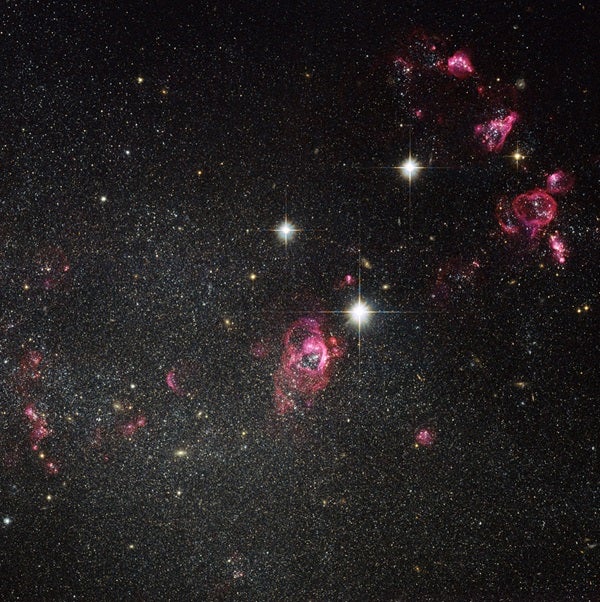The intricate glowing shells of gas in Holmberg II were created by the energetic life cycles of many generations of stars. High-mass stars form in dense regions of gas, and later in life expel strong stellar winds that blow away the surrounding material. At the very end of their lives, they explode in as supernovae Shock waves rip through these less dense regions, blowing out and heating the gas and forming the delicate shells we see today.
Holmberg II is a patchwork of dense star-forming regions and extensive barren areas with less material, which can stretch across thousands of light-years. As a dwarf galaxy, it has neither the spiral arms typical of galaxies like the Milky Way nor the dense nucleus of an elliptical galaxy. This makes Holmberg II, gravitationally speaking, a gentle haven where fragile structures such as these bubbles can hold their shape.
While the galaxy is unremarkable in size, Holmberg II does have some intriguing features. As well as its unusual appearance, which earned it a place in Halton Arp’s Atlas of Peculiar Galaxies, a treasure-trove of weird and wonderful objects, the galaxy hosts an ultra-luminous X-ray source in the middle of three gas bubbles in the top right of the image. There are competing theories as to what causes this powerful radiation — one intriguing possibility is an intermediate-mass black hole that is pulling in material from its surroundings.
This colorful image is a composite of visible and near-infrared exposures taken using the Wide Field Channel of Hubble’s Advanced Camera for Surveys.
The intricate glowing shells of gas in Holmberg II were created by the energetic life cycles of many generations of stars. High-mass stars form in dense regions of gas, and later in life expel strong stellar winds that blow away the surrounding material. At the very end of their lives, they explode in as supernovae Shock waves rip through these less dense regions, blowing out and heating the gas and forming the delicate shells we see today.
Holmberg II is a patchwork of dense star-forming regions and extensive barren areas with less material, which can stretch across thousands of light-years. As a dwarf galaxy, it has neither the spiral arms typical of galaxies like the Milky Way nor the dense nucleus of an elliptical galaxy. This makes Holmberg II, gravitationally speaking, a gentle haven where fragile structures such as these bubbles can hold their shape.
While the galaxy is unremarkable in size, Holmberg II does have some intriguing features. As well as its unusual appearance, which earned it a place in Halton Arp’s Atlas of Peculiar Galaxies, a treasure-trove of weird and wonderful objects, the galaxy hosts an ultra-luminous X-ray source in the middle of three gas bubbles in the top right of the image. There are competing theories as to what causes this powerful radiation — one intriguing possibility is an intermediate-mass black hole that is pulling in material from its surroundings.
This colorful image is a composite of visible and near-infrared exposures taken using the Wide Field Channel of Hubble’s Advanced Camera for Surveys.










